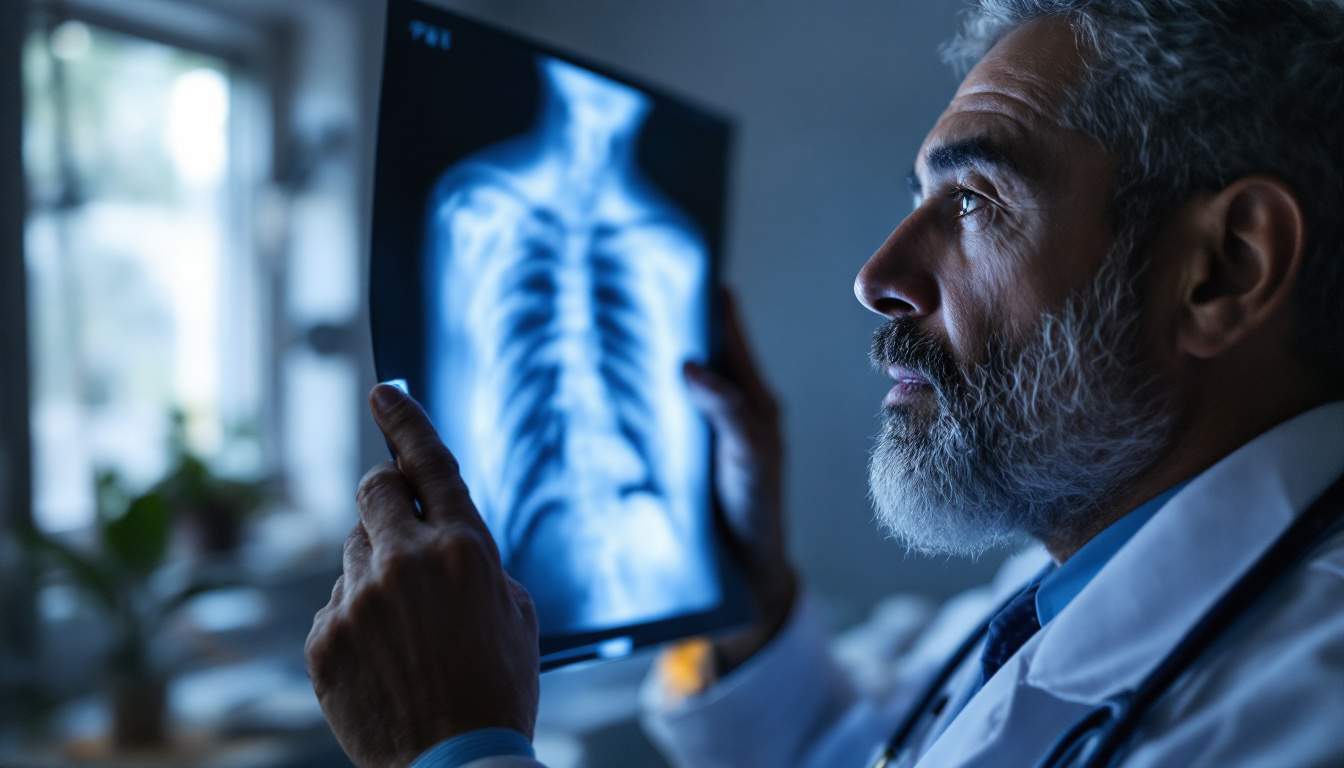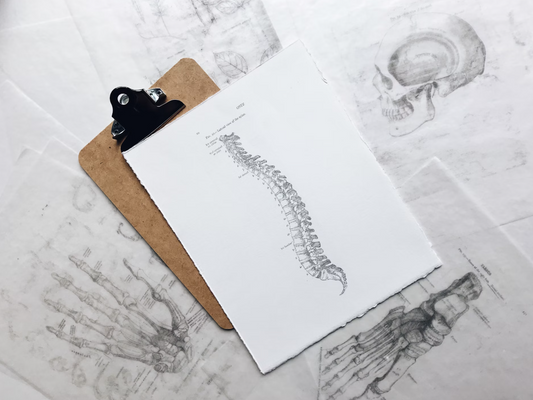Glossary: What is a Chest X-ray
Chest X-rays are a vital tool in modern medicine, allowing healthcare professionals to visualize the structures within the chest cavity. This article aims to provide a comprehensive understanding of chest X-rays, from their basic definition to interpreting results, alongside any risks involved. We encourage you to explore each section to enhance your understanding of this critical diagnostic procedure.
Understanding the Basics of a Chest X-ray
A Chest X-ray is a simple and painless imaging test that produces images of the heart, lungs, blood vessels, and bones within the chest. It plays a crucial role in diagnosing various conditions and monitoring the progress of diseases.
Definition of a Chest X-ray
In essence, a Chest X-ray uses electromagnetic radiation to create pictures of the structures within your chest. The X-ray machine sends out a small amount of radiation, which passes through the body and produces an image on a film or digital sensor. The density of different tissues affects how much radiation passes through, resulting in varying shades of black, white, and gray on the final image. This contrast allows radiologists to identify abnormalities, such as fluid accumulation or structural changes, that may indicate underlying health issues.
Purpose of a Chest X-ray
The primary purpose of a Chest X-ray is to aid in diagnosing conditions affecting the chest area. This can include detecting pneumonia, heart failure, fractures, tumors, or fluid in the lungs. Regular monitoring of chronic issues, such as lung disease, also makes Chest X-rays indispensable for many patients. Additionally, Chest X-rays are often used preoperatively to assess a patient’s lung health before undergoing surgery, ensuring that any potential complications can be addressed beforehand.
Brief History of a Chest X-ray
The discovery of X-rays by Wilhelm Conrad Röntgen in 1895 marked a turning point in diagnostic medicine. Chest X-ray procedures quickly followed, revolutionizing the way medical professionals could visualize internal organs. Over the years, advancements in technology have allowed for improved image quality and reduced radiation exposure, making Chest X-rays safer and more effective for patients. The introduction of digital radiography in the late 20th century further transformed the field, enabling faster image acquisition and the ability to manipulate images for enhanced diagnostic clarity. Today, Chest X-rays remain a fundamental tool in both emergency and routine healthcare settings, providing critical insights into patient health.
Procedure and Preparation for a Chest X-ray
Preparing for a Chest X-ray is typically straightforward, as patients are usually advised to wear loose-fitting clothing and remove any jewelry or accessories that could interfere with the imaging process. During the procedure, patients may be asked to stand or sit in front of the X-ray machine and take a deep breath, holding it for a few seconds while the image is captured. This helps to expand the lungs, providing a clearer view of the structures within the chest. The entire process usually takes only a few minutes, and patients can resume normal activities immediately afterward. It is important for patients to inform their healthcare provider if they are pregnant or suspect they might be, as this may influence the decision to proceed with the X-ray due to potential risks to the developing fetus.
Components of a Chest X-ray
Understanding the components involved in a Chest X-ray is essential to grasp its functionality. The process includes various elements that contribute to producing clear and informative images.
Anatomy in a Chest X-ray
A standard Chest X-ray typically captures a frontal (posteroanterior) view and sometimes a side (lateral) view of the chest. The anatomy visible in these images includes the lungs, heart, ribs, and major blood vessels. Skilled radiologists can interpret these structures and determine if they appear normal or abnormal based on size, shape, and density. For instance, the presence of fluid in the pleural space, known as pleural effusion, can be identified by the characteristic blunting of the costophrenic angles in the X-ray images. Additionally, abnormalities such as tumors or infections can manifest as unusual opacities, prompting further investigation and diagnosis.
The X-ray Machine
Modern X-ray machines are equipped with advanced technology that enhances image quality while minimizing radiation exposure. They consist of a tube that emits X-rays and a detector that captures the radiation that passes through the body. The design allows for various positioning of the patient to obtain the necessary views. Some machines even incorporate digital imaging technologies that allow for real-time feedback, enabling technicians to adjust settings on the fly for optimal results. This adaptability is crucial in pediatric cases or when dealing with patients who may have difficulty holding their breath or remaining still during the procedure.
The X-ray Film
Traditionally, X-rays were recorded on photographic film. However, most facilities now use digital systems, which provide quicker access to images and allow for easier sharing and storage. Digital X-ray images can be enhanced or altered to improve visibility and make analysis easier. This technological shift has also facilitated the integration of artificial intelligence in radiology, where algorithms can assist in identifying potential issues by comparing current images with vast databases of previous cases. This not only speeds up the diagnostic process but also helps in maintaining a high standard of accuracy in interpretations.
The Process of Getting a Chest X-ray
The process of obtaining a Chest X-ray is straightforward and designed to be as efficient as possible for the patient. It usually takes just a few minutes, making it convenient for both patients and healthcare providers.
Preparation for a Chest X-ray
Preparation for a Chest X-ray is minimal. Patients are usually advised to wear loose clothing without metal fastenings, as metal can interfere with the imaging process. If you are pregnant or suspect you might be, it’s important to inform the technician, as precautions may need to be taken. Additionally, patients should remove any jewelry or accessories that could obstruct the X-ray images. It’s also a good idea to inform the technician about any previous chest imaging or surgeries, as this information can help in interpreting the results more accurately.
During the X-ray Procedure
During the procedure, patients will be asked to stand or sit in front of the X-ray machine. The technician will position them, ensuring proper alignment for the best image. Patients are typically instructed to take a deep breath and hold it briefly while the image is captured to avoid any movement that may blur the results. The X-ray machine itself is designed to emit a controlled amount of radiation, which is carefully monitored to ensure safety. Patients may notice that the machine moves slightly during the imaging process, as it may take multiple angles to capture a comprehensive view of the chest area. This is all part of ensuring that the healthcare provider has the most accurate information for diagnosis.
After the X-ray Procedure
After the X-ray is completed, patients can resume their normal activities immediately. The images are reviewed by a radiologist, who will report the findings to the referring healthcare professional. Results are usually available within a few hours to a few days, depending on the facility. Patients are often encouraged to follow up with their doctor to discuss the results and any further steps that may be necessary. Understanding the implications of the X-ray findings is crucial, as they can provide insights into various conditions, such as infections, tumors, or chronic lung diseases. In some cases, additional imaging or tests may be recommended based on the initial results, ensuring a thorough evaluation of the patient’s health status.
Reading and Interpreting a Chest X-ray
Interpreting Chest X-rays is a specialized skill that involves understanding various patterns and densities seen on the images. Radiologists undergo extensive training to accurately analyze what they see. This training includes not only the technical aspects of image interpretation but also a deep understanding of human anatomy and pathology, allowing them to spot subtle changes that may indicate serious health concerns.
Understanding Shadows and Silhouettes
One of the key aspects of reading a Chest X-ray is recognizing shadows and silhouettes. Dense structures, like bones or tumors, appear white, while air-filled structures, such as the lungs, appear black. This contrast helps radiologists identify abnormalities that could signify underlying health issues. Additionally, the positioning of the patient during the X-ray can affect the appearance of these shadows; for instance, an upright position may reveal fluid levels in the pleural space more clearly than a supine position, providing further insight into the patient's condition.
Identifying Common Findings
Common findings on Chest X-rays include signs of infection, fluid accumulation, masses, or changes in lung structure. Conditions like pneumonia can present as white areas in the lungs, while heart enlargement may appear as increased silhouette size. Each finding helps guide further diagnostic tests or treatments. Furthermore, radiologists often look for signs of chronic conditions, such as emphysema, which may manifest as hyperinflated lungs or flattened diaphragms. Recognizing these patterns not only aids in immediate diagnosis but also helps in monitoring the progression of chronic diseases over time.
Role of Radiologists in Interpretation
Radiologists are trained medical doctors who specialize in interpreting medical images. Their expertise is crucial as they analyze the X-rays, consider the patient's history and symptoms, and provide a detailed report. This collaborative approach ensures that the patient receives the appropriate diagnosis and management plan. Moreover, radiologists often work closely with other healthcare professionals, including pulmonologists and primary care physicians, to discuss findings and determine the best course of action. This multidisciplinary collaboration enhances patient care and ensures that all aspects of a patient's health are considered in the diagnostic process.
Technological Advances in Radiology
In recent years, technological advancements have significantly improved the quality and efficiency of Chest X-ray interpretation. Digital radiography allows for enhanced image clarity and the ability to manipulate images for better visualization of subtle details. Additionally, artificial intelligence (AI) is increasingly being integrated into radiology, assisting radiologists by highlighting potential areas of concern and streamlining the diagnostic workflow. These innovations not only expedite the interpretation process but also reduce the likelihood of human error, ultimately leading to improved patient outcomes and more precise treatment plans.
Risks and Safety Measures in Chest X-rays
While Chest X-rays are generally safe, as with any medical procedure, there are some risks and safety measures to consider.

Exposure to Radiation
Chest X-rays involve exposure to a small amount of radiation. However, the benefits often outweigh the risks, especially when they contribute to diagnosing potentially serious conditions. Healthcare professionals work to minimize exposure, using modern technology that requires less radiation than earlier methods. Digital X-ray systems, for instance, have significantly improved image quality while reducing the radiation dose, making the process safer for patients. Additionally, the amount of radiation from a single Chest X-ray is comparable to the natural background radiation a person receives over a few days, further emphasizing the relative safety of the procedure.
Pregnancy and X-rays
For pregnant individuals, the risks associated with radiation exposure are carefully evaluated. X-rays are generally avoided unless absolutely necessary. If a Chest X-ray is required, precautions such as shielding the abdomen can be taken to protect the developing fetus. Moreover, healthcare providers often consider alternative imaging methods, such as ultrasound or MRI, which do not involve ionizing radiation. In cases where a Chest X-ray is deemed essential, the timing of the procedure may be adjusted to minimize risk, typically opting for the second or third trimester when the fetus is more developed and less vulnerable.
Safety Precautions in X-ray Procedures
Safety measures in X-ray procedures include wearing protective gear like lead aprons for patients and technicians. Facilities also follow strict guidelines to ensure minimal radiation exposure while achieving optimal results. Communication between patient and health care providers is paramount to address any concerns before the procedure. Patients are encouraged to inform their healthcare team about any previous X-rays or imaging studies, as this information can help in assessing cumulative radiation exposure. Additionally, the implementation of quality control measures in radiology departments ensures that equipment is functioning properly, further enhancing patient safety and the accuracy of the diagnostic results.
Understanding the Benefits
Despite the risks, the benefits of Chest X-rays are substantial. They play a crucial role in diagnosing a variety of conditions, from pneumonia and lung cancer to heart failure and tuberculosis. Early detection through X-rays can lead to timely treatment, significantly improving patient outcomes. Furthermore, Chest X-rays are often a first step in a comprehensive diagnostic process, guiding healthcare providers in determining the necessity for further testing or intervention. The ability to visualize the lungs and surrounding structures quickly and effectively makes Chest X-rays an invaluable tool in modern medicine, allowing for prompt decision-making in emergency situations.
Frequently Asked Questions about Chest X-rays
A number of common questions arise regarding Chest X-rays. Here are some of the most frequently asked inquiries.

Can I get a Chest X-ray while pregnant?
While it is generally advisable to avoid unnecessary X-rays during pregnancy, there may be situations where a Chest X-ray is necessary for the mother’s health. In such cases, precautions will be taken to minimize any potential risks to the fetus. Healthcare professionals often use lead shields to protect the abdomen and pelvis, ensuring that the developing baby is shielded from radiation exposure as much as possible. It's crucial for pregnant patients to discuss their specific situation with their healthcare provider, who can assess the risks and benefits of proceeding with the X-ray.
How often can I get a Chest X-ray?
The frequency of Chest X-rays depends on individual health needs. Some patients may require periodic X-rays to monitor specific conditions, while others may only need one for diagnostic purposes. Your healthcare provider will determine the appropriate schedule based on your medical history. For instance, individuals with chronic respiratory conditions, such as COPD or asthma, might need regular imaging to track the progression of their disease. Conversely, a person with a suspected infection might only need a single X-ray to confirm the diagnosis. Regular follow-ups and discussions with your healthcare team are essential to ensure the best care.
What do abnormal results mean?
Abnormal results on a Chest X-ray can indicate several conditions ranging from infections to more severe issues like tumors or fluid accumulation. It's essential for such findings to be evaluated in conjunction with symptoms and other diagnostic tests to arrive at an accurate diagnosis. Sometimes, an abnormal X-ray may lead to further imaging studies, such as a CT scan, to provide a more detailed view of the chest. Additionally, the context of the patient's overall health, including factors like smoking history or exposure to environmental toxins, plays a significant role in interpreting these results. Understanding the implications of abnormal findings can help patients navigate the next steps in their healthcare journey.
In conclusion, understanding a Chest X-ray extends beyond its immediate visual representation. It encompasses knowledge of its history, purpose, components, procedures, interpretations, and safety measures. By being informed, patients can engage actively in their healthcare decisions. Moreover, being proactive about questions and concerns regarding Chest X-rays can lead to more personalized care, ensuring that each patient feels supported and informed throughout their diagnostic process.
If you're seeking a deeper understanding of your respiratory health beyond the occasional Chest X-ray, Alveo's innovative Continuous Respiratory Wearable is designed for everyday use to keep you informed about your breathing patterns. With Alveo, you can benefit from real-time respiratory monitoring with alerts, personalized breathing routines tailored to your lung capacity, and valuable insights into how your environment affects your breathing. Experience the lightness and comfort of our wearable technology that empowers you to take control of your respiratory well-being. Ready to breathe smarter? Sign up on our waiting list today and be among the first to revolutionize the way you monitor your respiratory health with Alveo.




